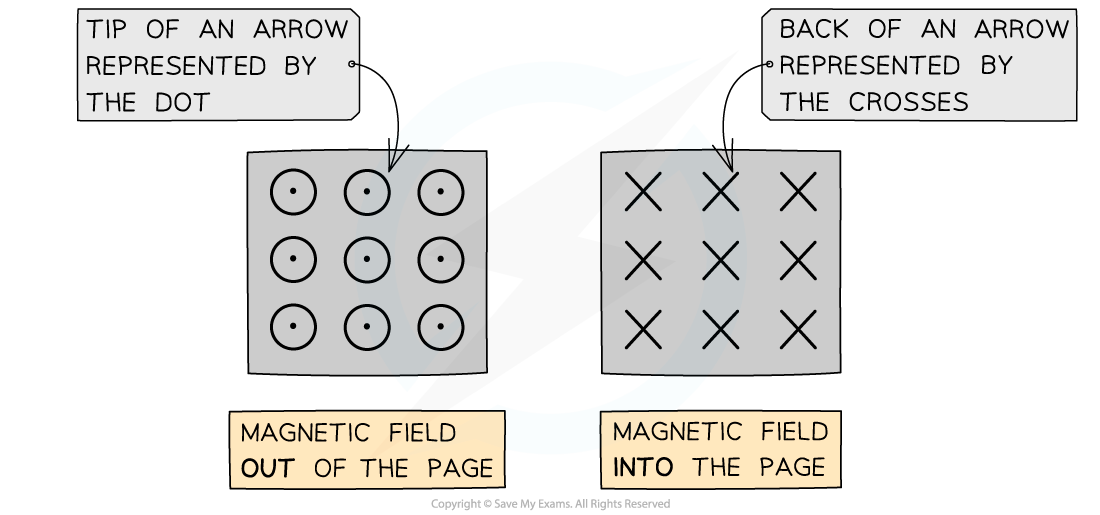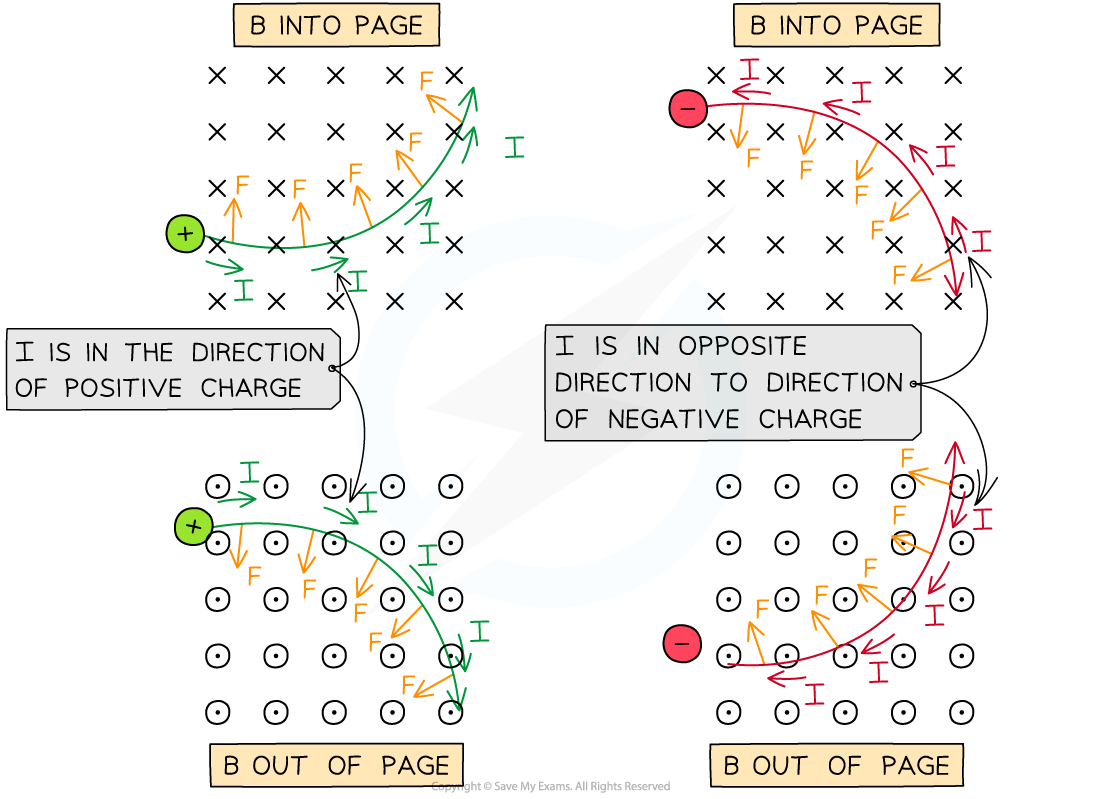Fleming's Left-Hand Rule (OCR A Level Physics) : Revision Note
Fleming's Left-Hand Rule
Fleming’s left hand rule can be used to determine the direction of the magnetic force on a moving charged particle in a magnetic field
The First Finger = direction of the magnetic field
The Second Finger = direction of conventional current (i.e. the velocity of a moving positive charge)
The Thumb = direction of the magnetic force
Fleming's Left Hand Rule is illustrated in the image below:

Fleming's Left Hand Rule shows the magnetic force, magnetic field and conventional current (flow of positive charge) are all perpendicular to each other
Since this is represented in 3D space, sometimes the flow of charge, magnetic force or magnetic field could be directed into or out of the page, not just left, right, up and down
The direction of the magnetic field into or out of the page in 3D is represented by the following symbols:
Dots (sometimes with a circle around them) represent the magnetic field directed out of the plane of the page
Crosses represent the magnetic field directed into the plane of the page

The magnetic field into or out of the page is represented by circles with dots or crosses
The way to remember this is by imagining an arrow used in archery or darts:
If the arrow is approaching head−on, such as out of a page, only the very tip of the arrow can be seen (a dot)
When the arrow is moving away, such as into a page, only the cross of the feathers at the back can be seen (a cross)
An Electron Moving in a Magnetic Field
The maximum magnetic force on a moving charged particle is always perpendicular to its velocity
This means magnetic forces cause charged particles to move in a circle
The direction of magnetic force on the charged particle can be determined using Fleming's Left Hand Rule
The image below shows an electron incident on a uniform magnetic field B directed into the page:

An electron moving to the left as shown is equivalent to a conventional positive charge or current moving to the right. Using Fleming's Left Hand Rule, the direction of the force can be determined
According to Fleming's Left Hand Rule:
B is directed into the page, therefore the first finger should point into the page
The conventional current (or velocity of a positive charge) is directed to the right (because an electron is moving to the left), therefore the second finger should point to the right
Therefore, the force on the electron as shown by the thumb is initially upwards as it enters the magnetic field
The force due to the magnetic field is always perpendicular to the velocity of the electron
Note: this is equivalent to circular motion
Therefore, the magnetic force on a moving charge is a centripetal force
The centripetal force is what keeps moving charges following a circular trajectory
Examples of the direction of the magnetic force on positive and negative particles are:

The direction of the magnetic force F on positive and negative particles in a B field in and out of the page
Fleming’s Left Hand Rule can also be used to find the direction of the force, magnetic field and velocity
The key difference is that the second finger, representing current I (direction of positive charge), can now be used as the direction of velocity, v of a positive charge
Worked Example
A current flows perpendicularly to a uniform magnetic field as shown in the diagram below.

As a result, the conductor carrying the current experiences a magnetic force, F.
Determine the direction of the current flowing in the conductor.
Answer:
Step 1: Apply the instructions for Fleming's Left Hand Rule
Using Fleming’s Left Hand Rule for the quantities given:
First finger is the magnetic field, B = into the page (or screen!)
Thumb is the direction of the magnetic force F = vertically downwards
Step 2: Determine the direction of the conventional current
The first finger should be pointing into the page (or screen!) along the direction of the field
Rotating the entire hand allows the thumb to point downwards, along the direction of force
The second finger should be pointing towards the left of the page (or screen!)
This is the direction of conventional current in the wire, i.e., from right to left

Examiner Tips and Tricks
You will certainly need to apply Fleming's Left Hand Rule in your examination, at some point, whenever there is a current or charge flowing in a magnetic field. Remember, it is used to give the direction of either the magnetic force F, the magnetic field B, or the conventional current (or flow of positive charge) I.
The most important point when using Fleming's left hand rule is the direction of the charge (or current flow). This is always the direction of positive charge. Therefore, for electrons, or negatively charged ions, you should point your second finger for the current in the opposite direction to its motion.
As ever, you will gain more confidence twisting your arm in funny positions with three fingers at right-angles the more questions you practise: the more, the better!

You've read 0 of your 5 free revision notes this week
Sign up now. It’s free!
Did this page help you?
